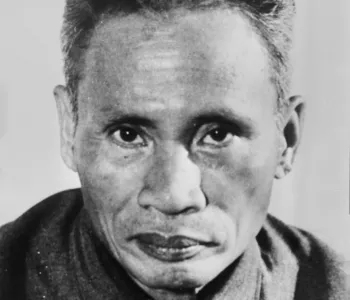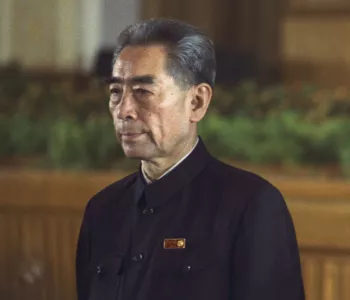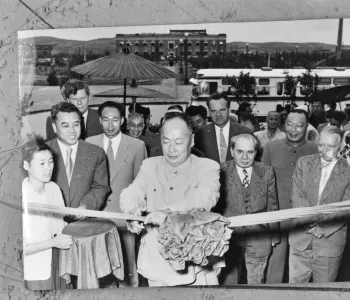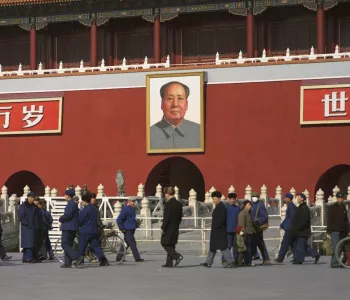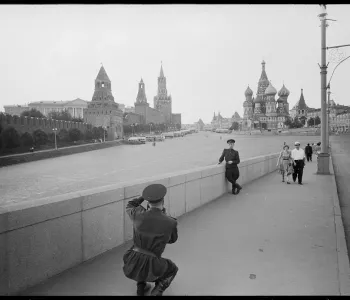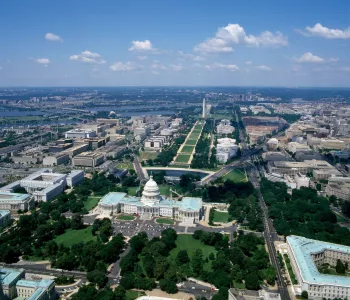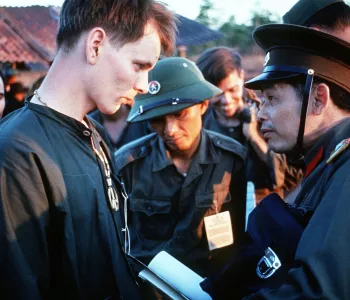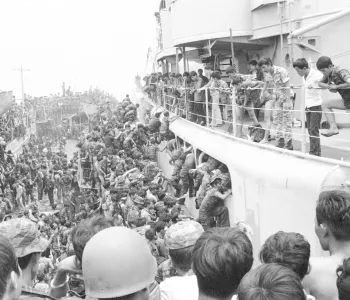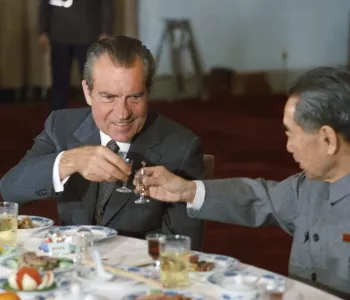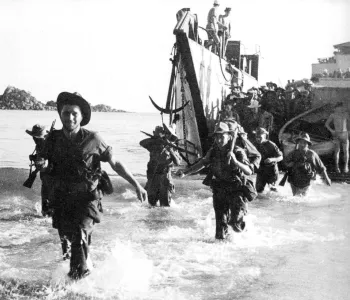d'Vinci

Võ, Nguyên Giáp (Vo Nguyen Giap) 1911- 2013
Võ Nguyên Giáp (Vo Nguyen Giap) was the Defense Minister of North Vietnam from 1944-1980. He was the principal individual in charge of North Vietnamese strategy during the Vietnam War.

Vo Nguyen Giap was born in Quangbinh Province, in Central Vietnam, of an impoverished Mandarin family. Educated in a French lycée in Hue and at Hanoi University, he joined the Indochina Communist Party in the 1930s. On the outbreak of World War II, he fled to China to join Vietnamese Communist leader Ho Chi Minh at Chingsi, where, in May 1941, the Vietnamese Independence League, abbreviated to the name Viet Minh, was formed. In autumn 1944, Ho gave his blessing to the formation of armed propaganda teams under Giap's command, which, in April 1945, became the People's Liberation Army.
Giap served as interior minister in the revolutionary government that Ho Chi Minh created on the surrender of the Japanese in 1945; he is alleged to have directed brutal purges against non-Communist elements. In 1946, as tension mounted between the Viet Minh and the French, Giap became defense minister. An avid student of military history, he emerged as a major Communist strategist and military organizer of the Vietnam wars. He was influenced by Mao Zedong’s theories of a three-stage escalation of revolutionary war from guerrilla warfare, to parity with the incumbent forces, and finally to the third phase, in which the insurgents would overwhelm the occupiers. Giap's strengths as a military commander lay in his meticulous attention to organization, particularly logistics. His weakness was his impatience to reach the Maoist "third phase," which caused him to undertake campaigns, or persist in costly actions, beyond the capabilities of his forces.
The Communist victory in China and Mao's decision to aid the Viet Minh caused Giap to conclude in February 1950 that the time had come to move to the third phase of revolution. The spectacular collapse under Viet Minh pressure of a series of French posts along the Chinese frontier in October 1950 appeared to give credibility to Giap's analysis. However, when Viet Minh forces assaulted the Tonkin Delta in 1951, they were driven back with significant losses. Although the French defeat at Dien Bien Phu in 1954 enhanced Giap's military reputation, it appears that most of the major strategic decisions of the Indochina War were taken by the Chinese, often over the objections of Giap.
Following the Geneva Conference, which partitioned Vietnam at the seventeenth parallel, Giap remained a voice for reunification by military means, even in the face of escalating U.S. involvement in South Vietnam in the early 1960s. Given the collective nature of Communist decision making, it is impossible to know exactly how far Giap was responsible for the decision to attack Khe Sanh in 1967, for the Tet offensive of 1968, or for the 1972 Easter offensive, for which he was a primary advocate. By the time South Vietnamese resistance collapsed in 1975, much of the direction of the war had passed to General Van Tien Dung. After the war, Giap was given short-term assignments until he retired as defense minister in 1980, and from the politburo in 1982. Critics feel that Giap's military reputation has been inflated by his self-promotion, which contrasts markedly with the usual anonymity of Communist commanders, and by the adulation of his adversaries, particularly the French.
Gen. Vo Nguyen Giap is perhaps the most important figure in the early history of communist Vietnam -- with the exception of Ho Chi Minh. At the end of World War II, Ho named Giap commander in chief of the Viet Minh forces fighting French colonial rule. Giap orchestrated the defeat of the French at the battle of Dien Bien Phu in 1953 and remained minister of defense of the newly independent Democratic Republic of Vietnam. He was the chief North Vietnamese military leader in the subsequent war against U.S. forces.
Soldier and government official of North Vietnam and later of the Socialist Republic of Vietnam. A nationalist, he joined the Vietnamese Communist party in the 1930s, later joining Ho Chi Minh in China. Giap helped to organize the Viet Minh forces, fighting to oust the Japanese in World War II and the French after the war; he became commander of the Viet Minh in 1946. A master of guerrilla warfare, he was credited with the defeat of the French at Dienbienphu (1954) and later directed the strategy of the North in the Vietnam War, notably in the 1968 Tet offensive In addition to his position as commander in chief, Giap was also deputy prime minister and minister of defense. He resigned from defense in 1980 and was dropped from the politburo in 1982, but remained deputy prime minister until 1991.
Associates also have described him as forceful, arrogant, impatient and dogmatic. At least in earlier years, he was ruthlessly ambitious and extraordinarily energetic, with a touch of vanity suggesting to interviewers that he should be considered an Asian Napoleon. He is said to be fiercely loyal to those of his political faction who grant him unreserved loyalty. He once told an associate that he took a "Darwinian view" of politics, and is said always to have been indifferent to arguments or reasoning based mainly on dogma. He always has been surrounded by political enemies and the victim of decades of sly whispers campaigns so common in Vietnam. (A typical whisper: General Dung, not Giap, planned the final successful at the battle of Dien Bien Phu because Giap had been struck down by diarrhea.)
He fled to China in 1939 when the French banned the Indochinese Communist Party, but returned in 1941. In 1945 he led the Viet Minh forces that defeated the Japanese, who occupied Vietnam during World War II. He brought French colonial rule to an end by winning the Battle of Dien Bien Phu (1954) in the First Indochina War, and he led the North Vietnamese forces that defeated the U.S. and South Vietnam in the Vietnam War (1955–75). He served in various roles in the postwar government of Vietnam until the early 1990s.
At the end of 1941 Giap found himself back in Vietnam, in the mountains, with orders to begin organizational and intelligence work among the Montagnards. Working with a local bandit named Chu Van Tan, Giap spent World War II running a network of agents throughout northern Vietnam. The information collected, mostly about the Japanese in Indochina, went to the Chinese Nationalist in exchange for military and financial assistance which in turn, supported communist organization building. Giap had little military prowess at his command, however, and used what he did have to systematically liquidate rice landlords who opposed the communist.
During these early years, Giap led Party efforts at organization busting which, with the connivance of the French, emasculated competing non-communist nationalist organizations, killing perhaps some 10,00 individuals (although these figures come from surviving nationalist and may be exaggerated). One of the liquidation techniques used by Giap's men was to tie victims together in batches, like cordwood, and toss them into the Red River, the victims thus drowning while floating out to sea a method referred to as "crab fishing." Giap's purge also extended to the newly created Viet Minh government: of the 360 original National Assembly members elected in 1946, only 291 actually took their seats, of whom only 37 were official opposition and only 20 of these were left at the end of the first session. Giap arrested some 200 during the session, some of whom were shot. He also ordered the execution of the famed and highly popular South Vietnamese Viet Minh leader, Nguyen Binh.
With the Viet Minh war Giap faced his most challenging task, converting peasants cum guerrillas into fully trained soldiers through a combination of military training and political indoctrination. He built an effective army. Colonial powers always controlled the colonial countryside with only token military forces; they controlled the peasants because the peasants permitted themselves to be controlled. Giap built an army that changed that in Indochina.
Giap always was at his best when he was moving men and supplies around a battlefield, far faster than his foes had any right to expect. He did this against the French in 1951, infiltrating an entire army through their lines in the Red River Delta, and again in advance of the Tet offensive in 1968 when he positioned thousands of men and tons of supplies for a simultaneous attack on thirty-five major South Vietnamese population centers. If Giap is a genius as a general at all, he is, as the late Bernard Fall put it, a logistic genius. General Giap's strategic thinking early in the Vietnam War, from 1959 until at least 1966, was to let the NLF and PLAF do it by the Viet Minh War book. Cadres and battle plans in the form of textbooks were sent down the Ho Chi Minh Trail. Southern elements were instructed in the proper mobilization and motivation techniques, centered on the orthodox dau tranh strategy that had worked with the French and in which Giap had full faith. Certain adjustments might be necessary with respect to political dau tranh and some minor adaptations of armed dau tranh might be required, his writings at this time indicated that essentially the necessary doctrine was in existence and was in place.
What changed Giap's thinking, and his assumption that the war against the Americans could be a continuation of the war against the French, was the battle of Ia Drang Valley, the first truly important battle of the war. Giap's troops veterans of Dien Bien Phu, when thrown against green First Cavalry Division soldiers, experienced for the first time the full meaning of American-style conduct of war: the helicopters, the lightweight bullet, sophisticated communications, computerized military planning, an army that moved mostly vertically and hardly ever walked. Technology had revolutionized warfare, Giap acknowledged in Big Victory, Great Task, a book written to outline his strategic response to the U.S. intervention. The answer he said, was to match the American advantage in mass and movement or, where not possible, to shunt it aside. He was still searching for the winning formula when suddenly he was handed victory. The South Vietnamese Army which had stood and fought under far worse conditions in January 1975, under minor military pressure, began to collapse. Soon in could not fight coherently. Giap was handed a victory he neither expected at the time nor deserved. How much command responsibility Giap had in the last days of the war, in 1975, is debated - much direction had passed to General Dung but is unimportant in terms of distributing laurels, since none was deserved by any PAVN general.
After the Vietnam War General Giap slowly began to fade the scene, withdrawing gradually from day-to-day command of PAVN. General Dung began to take up the reins of authority. Giap was given a series of relatively important short term task force assignments. He supervised the initial assumption by PAVN of various production and other postwar economic duties. He reorganized and downgraded the PAVN political commissar system, as the battle organized Reds and Experts tilted ever more clearly towards the latter. He defended PAVN's budget against the sniping attack of cadres in the economic sector.
When the "Pol Pot problem" developed truly serious dimensions in late 1977, Giap returned to the scene. He spent most of 1978 organizing an NLF style response for Kampuchea, that in creation of a Liberation Army, a Liberated Area, a radio Liberation, and a standby Provisional Revolutionary Government. This was a tried method, but by its nature, slow. Apparently the politburo judged it did not have time for protracted conflict, and so in 1978 opted in favor of a Soviet-style solution: tanks across the border, invasion and occupation of Kampuchea. Giap opposed it, although evidence of this is mostly inferential, holding that a quick military solution was not possible, that Pol Pot would embrace a dau tranh strategy against PAVN and the result would be a bogged down war. Giap proved to be painfully correct and, for the sin of being right when all others are wrong in a collective leadership decision-making process, was eased out of Politburo level politics. Apparently all factions ganged up on him, but his removal was designed to eliminate Giap as factional infighting without tarnishing Giap the legend. It appears he did not resist this power play as he might have done, with possibly bloody consequences, which may be a tribute to his better judgments.
Today Giap still is on the Vietnamese scene, but plays a lesser role. He has taken upon himself the task of lifting Vietnam by its technological boot straps, has become the leading figure in the drive to raise the country's technical and scientific capability. This requires, among other things, soliciting continued Soviet assistance, something Giap is able to do well because of the regard for him in the USSR. He confers frequently with Soviet advisors in Hanoi and in the Soviet Union; in 1980 he went to Moscow three times in a nine-month period.
